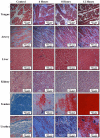Effects of Thermal Preconditioning on Tissue Susceptibility to Histotripsy
- PMID: 26318560
- PMCID: PMC4648696
- DOI: 10.1016/j.ultrasmedbio.2015.07.016
Effects of Thermal Preconditioning on Tissue Susceptibility to Histotripsy
Abstract
Histotripsy is a non-invasive ablation method that mechanically fractionates tissue by controlling acoustic cavitation. Previous work has revealed that tissue mechanical properties play a significant role in the histotripsy process, with stiffer tissues being more resistant to histotripsy-induced tissue damage. In this study, we propose a thermal pretreatment strategy to precondition tissues before histotripsy. We hypothesize that a thermal pretreatment can be used to alter tissue stiffness by modulating collagen composition, thus changing tissue susceptibility to histotripsy. More specifically, we hypothesize that tissues will soften and become more susceptible to histotripsy when preheated at ∼60°C because of collagen denaturation, but that tissues will rapidly stiffen and become less susceptible to histotripsy when preheated at ∼90°C because of collagen contraction. To test this hypothesis, a controlled temperature water bath was used to heat various ex vivo bovine tissues (tongue, artery, liver, kidney medulla, tendon and urethra). After heating, the Young's modulus of each tissue sample was measured using a tissue elastometer, and changes in tissue composition (i.e., collagen structure/density) were analyzed histologically. The susceptibility of tissues to histotripsy was investigated by treating the samples using a 750-kHz histotripsy transducer. Results revealed a decrease in stiffness and an increase in susceptibility to histotripsy for tissues (except urethra) preheated to 58°C. In contrast, preheating to 90°C increased tissue stiffness and reduced susceptibility to histotripsy for all tissues except tendon, which was significantly softened due to collagen hydrolysis into gelatin. On the basis of these results, a final set of experiments were conducted to determine the feasibility of using high-intensity focused ultrasound to provide the thermal pretreatment. Overall, the results of this study indicate the initial feasibility of a thermal pretreatment strategy to precondition tissue mechanical properties and alter tissue susceptibility to histotripsy. Future work will aim to optimize this thermal pretreatment strategy to determine if this approach is practical for specific clinical applications in vivo without causing unwanted damage to surrounding or overlying tissue.
Keywords: High-intensity focused ultrasound; Histotripsy; Thermal therapy; Tissue stiffness.
Copyright © 2015 World Federation for Ultrasound in Medicine & Biology. Published by Elsevier Inc. All rights reserved.
Figures









References
-
- Baldwin D. Sous vide cooking: A review. International Journal of Gastronomy and Food Science. 2012;1:15–30.
-
- Coad JE, Kosari K, Humar A, Sielaff TD. Radiofrequency ablation causes ‘thermal fixation’ of hepatocellular carcinoma: a post-liver transplant histopathologic study. Clin Transplant. 2003;17:377–84. - PubMed
-
- Ding J, Jing X, Liu J, Wang Y, Wang F, Du Z. Comparison of two different thermal techniques for the treatment of hepatocellular carcinoma. Eur J Radiol. 2013;82:1379–84. - PubMed
-
- Fratzl P. Collagen: Structure and Mechanics. Springer Science+Business Media, LLC; New York, NY: 2008.
Publication types
MeSH terms
Grants and funding
LinkOut - more resources
Full Text Sources
Other Literature Sources

